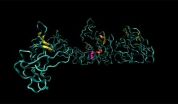(Press-News.org) WHAT:
An experimental vaccine designed to spur production of antibodies against a key malaria parasite protein, AMA1, was developed more than decade ago by scientists from the National Institute of Allergy and Infectious Diseases (NIAID), part of the National Institutes of Health. It showed promise in test-tube and animal experiments and in early-stage clinical trials, but returned disappointing results in recent human trials conducted in malaria-endemic countries.
Now, the NIAID scientists have improved on their original vaccine with a new candidate that delivers AMA1 protein together with part of a second parasite protein called RON2. In a natural infection, malaria parasites use the AMA1-RON2 complex to attach to and invade red blood cells. When injected into mice as a complex, the AMA1-RON2 vaccine prompted robust antibody production and protected the animals from a lethal form of mouse malaria. Moreover, when antibodies produced in response to AMA1-RON2 vaccine were administered to other, non-vaccinated mice, those animals received some protection from infection as well. Further analysis showed that the improved antibody response following AMA1-RON2 vaccination was due to an increased proportion of antibodies aimed directly at the AMA1-RON2 junction, which made them better at inhibiting parasite invasion.
The researchers note that this strategy of vaccination with the functional protein AMA1-RON2 complex could be tested in the next generation of human malaria vaccines. Such vaccines, which would contain multiple AMA1 sequences in complex with RON2, might induce antibodies targeted to a range of genetically diverse malaria parasites.
INFORMATION:
ARTICLE:
P Srinivasan et al. Immunization with a functional protein complex required for erythrocyte invasion protects against lethal malaria. Proceedings of the National Academy of Sciences DOI: 10.1073/pnas.1409928111 (2014).
WHO:
Louis Miller, M.D., and Prakash Srinivasan, Ph.D., Laboratory of Malaria and Vector Research, NIAID, are available to comment.
CONTACT:
To schedule interviews, please contact the NIAID Office of Communications, (301) 402-1663, niaidnews@niaid.nih.gov.
Visit NIAID's Malaria webpage for more news and information (http://www.niaid.nih.gov/topics/malaria/Pages/default.aspx).
NOTE: A full version of this paper will be available after 3 p.m. Eastern Time Monday, June 23 (http://www.pnas.org/cgi/doi/10.1073/pnas.1409928111).
NIAID conducts and supports research—at NIH, throughout the United States, and worldwide—to study the causes of infectious and immune-mediated diseases, and to develop better means of preventing, diagnosing and treating these illnesses. News releases, fact sheets and other NIAID-related materials are available on the NIAID Web site at http://www.niaid.nih.gov.
About the National Institutes of Health (NIH):
NIH, the nation's medical research agency, includes 27 Institutes and Centers and is a component of the U.S. Department of Health and Human Services. NIH is the primary federal agency conducting and supporting basic, clinical, and translational medical research, and is investigating the causes, treatments, and cures for both common and rare diseases. For more information about NIH and its programs, visit http://www.nih.gov.
NIH...Turning Discovery Into Health®
Vaccine made from complex of two malaria proteins protects mice from lethal infection
2014-06-23
ELSE PRESS RELEASES FROM THIS DATE:
Rett syndrome drug shows promise in clinical trial
2014-06-23
CAMBRIDGE, MA -- Rett syndrome, a rare genetic disorder that causes mental retardation, autism, and physical deformities, has no cure. However, a small clinical trial has found that a growth factor known as IGF1 can help treat some symptoms of the disease.
Children who received the drug for four weeks showed improvements in mood and anxiety, as well as easier breathing, in a trial led by researchers at Boston Children's Hospital. MIT scientists first identified IGF1 as a possible treatment for Rett syndrome in 2009.
"This trial shows that IGF1 is safe in the cohort ...
New analysis reveals previously 'hidden diversity' of mouth bacteria
2014-06-23
MBL, WOODS HOLE, MA—A new computational method for analyzing bacterial communities has uncovered closely related, previously indistinguishable bacteria living in different parts of the human mouth. The technique, developed by Marine Biological Laboratory (MBL) scientists, provides high taxonomic resolution of bacterial communities and has the capacity to improve the understanding of microbial communities in health and disease. The study will be published in PNAS Online Early Edition the week of June 23-27, 2014.
An important step in understanding the role of oral bacteria ...
Computational technique provides new insight into oral microbiome
2014-06-23
CAMBRIDGE, Mass., June 23, 2014—Scientists have applied a new technique to comprehensively analyze the human oral microbiome—providing greater knowledge of the diversity of the bacteria in the mouth. For the first-time, scientists can provide high-resolution bacterial classification at the sub-species level. This work will enable researchers to more closely examine the role of bacterial communities in health and disease.
The study, "Oligotyping analysis of the human oral microbiome," will be published in the Proceedings of the National Academy of Sciences and available ...
Delivering drugs on cue
2014-06-23
June 23, Boston -- Current drug-delivery systems used to administer chemotherapy to cancer patients typically release a constant dose of the drug over time - but a new study challenges this "slow and steady" approach and offers a novel way to locally deliver the drugs "on demand," as reported in the Proceedings of the National Academy of Sciences (PNAS).
Led by David J. Mooney, Ph.D., a Core Faculty member at Harvard's Wyss Institute for Biologically Inspired Engineering and the Robert P. Pinkas Family Professor of Bioengineering at the Harvard School of Engineering ...
Bone loss persists 2 years after weight loss surgery
2014-06-23
CHICAGO, IL — A new study shows that for at least two years after bariatric surgery, patients continue to lose bone, even after their weight stabilizes. The results—in patients undergoing gastric bypass, the most common type of weight loss surgery—were presented Monday at the joint meeting of the International Society of Endocrinology and the Endocrine Society: ICE/ENDO 2014 in Chicago.
"The long-term consequences of this substantial bone loss are unclear, but it might put them at increased risk of fracture, or breaking a bone," said Elaine Yu, MD, MSc, the study's principal ...
A disease of mistaken identity
2014-06-23
The symptoms of Cushing disease are unmistakable to those who suffer from it – excessive weight gain, acne, distinct colored stretch marks on the abdomen, thighs and armpits, and a lump, or fat deposit, on the back of the neck. Yet the disorder often goes misdiagnosed.
To help combat misdiagnosis, Saleh Aldasouqi, an associate professor in the College of Human Medicine at Michigan State University, is drawing more attention to the rare disease through a case study, which followed a young patient displaying classic, yet more pronounced signs of the condition.
Caused ...
Date labeling confusion contributes to food waste
2014-06-23
Date labeling variations on food products contribute to confusion and misunderstanding in the marketplace regarding how the dates on labels relate to food quality and safety, according to a scientific review paper in the July issue of Comprehensive Reviews in Food Science and Food Safety. This confusion and misunderstanding along with different regulatory date labeling frameworks, may detract from limited regulatory resources, cause financial loss, and contribute to significant food waste.
In the United States, the United States Department of Agriculture Economic Research ...
Understanding the ocean's role in Greenland glacier melt
2014-06-23
The Greenland Ice Sheet is a 1.7 million-square-kilometer, 2-mile thick layer of ice that covers Greenland. Its fate is inextricably linked to our global climate system.
In the last 40 years, ice loss from the Greenland Ice Sheet increased four-fold contributing to one-quarter of global sea level rise. Some of the increased melting at the surface of the ice sheet is due to a warmer atmosphere, but the ocean's role in driving ice loss largely remains a mystery.
Research by scientists at Woods Hole Oceanographic Institution (WHOI) and the Univ. of Oregon sheds new light ...
Protecting and connecting the Flathead National Forest
2014-06-23
A new report from the Wildlife Conservation Society (WCS) calls for completing the legacy of Wilderness lands on the Flathead National Forest in Montana. The report identifies important, secure habitats and landscape connections for five species—bull trout, westslope cutthroat trout, grizzly bears, wolverines, and mountain goats. These iconic species are vulnerable to loss of secure habitat from industrial land uses and/or climate change.
Located in northwest Montana adjacent to Glacier National Park, the 2.4 million-acre Flathead Forest is a strategic part of the stunning ...
Ferroelectric switching seen in biological tissues
2014-06-23
Measurements taken at the molecular scale have for the first time confirmed a key property that could improve our knowledge of how the heart and lungs function.
University of Washington researchers have shown that a favorable electrical property is present in a type of protein found in organs that repeatedly stretch and retract, such as the lungs, heart and arteries. These findings are the first that clearly track this phenomenon, called ferroelectricity, occurring at the molecular level in biological tissues.
The researchers published their findings online June 23 ...





